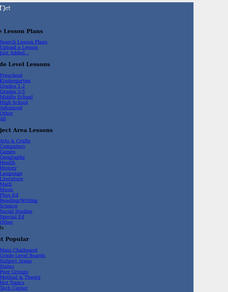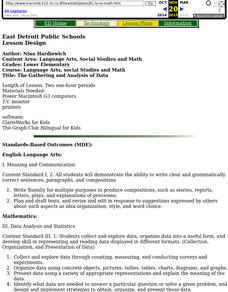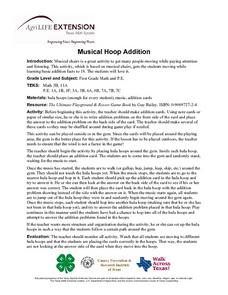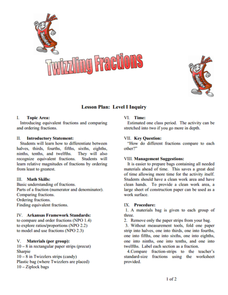Curated OER
Ring Toss Math
Young mathematicians play Ring Toss Math to find sums and differences to 18. If you're looking for an engaging, in-class game to help reinforce these mathematical concepts, this instructional activity could be for you!
Curated OER
Gone Lobstering
This simple lesson has young mathematicians consider all of the expenses, and monetary rewards a typical lobsterman encounters when going about his business. Given a few pieces of information, pupils must figure out a lobsterman will...
Education World
Greater Than or Less Than With "Mr. Great"
Those tricky symbols for greater than and less than have stumped young mathematicians for generations. Mr. Great is a paper plate cut into a Pac-Man shape that can be used to keep track of which direction the symbols should face. This...
Curated OER
The Gathering and Analysis of Data
Young mathematicians gather data on a topic, graph it in various forms, interpret the information, and write a summary of the data. They present their data and graphs to the class.
BBC
Reception
A nice instructional activity on recognizing and counting from one to nine is here for you. In it, learners hold up number cards which reflect the number of monkeys who are left during a reading of the story, "How Many Monkey's Left?" A...
Curated OER
Current Weather
A great year around activity that shows young mathematicians how the math skills they are learning are actually used in the real world. This exercise also helps learners begin to distinguish the difference between weather and climate. As...
Curated OER
Multiple Variables in an Equation
Young mathematicians apply problem-solving skills to equations that have more than one variable. They will work through the process to problem solve and discover the solution.
Curated OER
Measure: Bearings and Scale Drawings
Young mathematicians practice measuring acurately with a protractor. They convert measurements using a scale factor, then translate the new information into diagrams. This lesson should be a hit in that it's mostly hands-on work with the...
Curated OER
Number: Rounding Off and Approximating
Young mathematicians access a website that leads them through three activities that enable them to practice their rounding and estimation skills when it comes to numbers and math word problems. There is also a very good worksheet...
Curated OER
Positive-Negative Charge Model For Integers
Use two different colors of bingo chips to represent positive and negative charges. Add and subtract them in a clear glass beaker to demonstrate how to add and subtract integers. This visual, along with a number line, will really help...
Curated OER
Musical Hoop Addition
Musical chairs is a great activity to get children moving while still paying attention and listening. This activity, which is based on musical chairs, gets students moving while learning basic addition facts. They hop from hoop to hoop...
Curated OER
100th Day Chick Hunt
Young mathematicians listen to The Wolf's Chicken Stew by Keiko Kasza and review number names on a pocket chart that shows numbers from 1 to 100. They locate 100 numbered cutout chicks hidden in the classroom and match them to the...
Curated OER
Detective Digis and the Computer Caper
Mathematicians participate in an hands-on activity to investigate the binary number system and write messages in binary code and have classmates decipher the messages. A said video on the topic does not seem to be available, but the...
Curated OER
Talking About Your Name in Math Terms
Add imagination and creativity to your math lesson. Young mathematicians investigate ways to express their names in mathematical terms. For instance, they can count the number of letters, analyze the geometric shapes of the letters, or...
University of Arkansas
Twizzling Fractions
Using food as a manipulative is one of the best ways to incorporate hands-on learning in the classroom. This hands-on approach allows young mathematicians to compare, order, and identify fractions with the use of Twizzlers® and fraction...
Curated OER
One Size Fits All, Part 1
Can you tell how tall someone is just by looking at their feet? In this activity, young mathematicians measure their height, arm span, and foot size, graph their findings, and answer questions about how these measurements are related....
Curated OER
Vector Lab
Here is a math lab that helps young mathematicians understand the real-life meaning for vector addition. By building a model using spring scales and washers as weight, and then calculating the vector addition using two different methods,...
Curated OER
Sharing Gum
Young mathematicians solve arithmetic and simple algebraic equations using properties of real numbers, equality, and inequality. Justifying the procedures is their next task. They solve a problem involving linear inequality and justify...
Curated OER
Factoring Polynomials
Young mathematicians examine the "Tic-tac-toe" factoring method to factor polynomials. They use algebra tiles to model solutions of binomial multiplication problems. They discuss strategies and observe teacher-made models for solving...
Curated OER
One-digit Division
Young mathematicians read the book, The Doorbell Rang. They examine the necessity of division in everyday life, such as cooking and sharing. They use paper cookies to construct equivalent sets.
Curated OER
Telling Time as an Everyday Use of Numbers
How can we estimate time? Have your young mathematicians make a clock. Then they compare and contrast types of clocks. They practice writing times in two different ways and make a book about telling time.
PBS
Remove One
With a set of 15 chips and a number line, learners predict what sums may occur with the rolling of two dice. When their sum comes up, they remove one of the chips from their number line with the objective of being the first to remove...
Curated OER
Goldilocks and the Coordinate Grids
Where this lesson idea is lacking in materials, it makes up for with creativity! Using "Goldilocks and the Three Bears" as the background, mathematicians plot points on a coordinate grid to create props for the story. The polygons all...
Curated OER
Cardinal and Ordinal Numbers
Good, basic practice for young mathematicians can be found on this worksheet. Learners must write the cardinal or ordinal number in the space after the number word. Some examples are; sixteen, thousand, eleventh. This could be used as...
Other popular searches
- Famous Mathematicians
- Great Mathematicians
- 5 Great Mathematicians
- Female Mathematicians
- Projects on Mathematicians
- Five Great Mathematicians
- The Great Mathematicians
- Mathematicians Fibonacci
- List of Great Mathematicians
- Hall of Great Mathematicians
- Whorls Famous Mathematicians
- The Old Grete Mathematicians

























